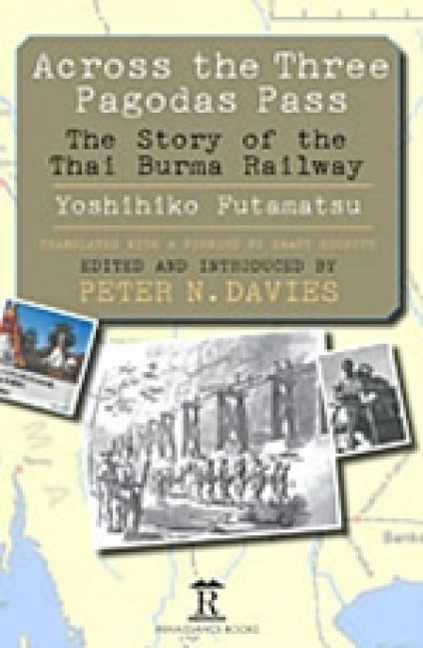Book contents
- Frontmatter
- Dedication
- Contents
- Acknowledgements
- Foreword
- Introduction
- Across the Three Pagodas Pass
- Translator’s Acknowledgements
- Preface
- Chapter 1 Departure for the Front
- Chapter 2 In Indo-China
- Chapter 3 Opening of Hostilities
- Chapter 4 The River Krian
- Chapter 5 The Malayan Campaign
- Chapter 6 The Fall of Singapore
- Chapter 7 Surrender
- Chapter 8 Shōnan: Light of the South
- Chapter 9 The Thai-Burma Railway
- Chapter 10 Preparing Construction
- Chapter 11 Banpong
- Chapter 12 Prisoners-of-War
- Chapter 13 Constructing the Railway
- Chapter 14 Thailand
- Chapter 15 The River Kwae Noi
- Chapter 16 The Mae Khlaung Bridge
- Chapter 17 Kanchanaburi
- Chapter 18 The Jungle
- Chapter 19 From Bangkok to Singapore
- Chapter 20 Rush Construction
- Chapter 21 The Base at Wanyai
- Chapter 22 The Labour Force
- Chapter 23 Survey Unit
- Chapter 24 Test Run
- Chapter 25 Bridge-Building and Shifting Earth
- Chapter 26 The Rainy Season: The Monsoon
- Chapter 27 Kinsaiyok
- Chapter 28 Diseases and Epidemics
- Chapter 29 Cattle Drive
- Chapter 30 Living in the Jungle
- Chapter 31 Soon to the Three Pagodas Pass
- Chapter 32 Towards the Setting Sun
- Chapter 33 Opening to Traffic
- Chapter 34 The Bombing
- Chapter 35 End of the War
- Chapter 36 Internment
- Chapter 37 Repatriation
- Footnote
- Postscript
- End Notes
- Glossary
- Bibliography
- Index
Chapter 5 - The Malayan Campaign
Published online by Cambridge University Press: 13 May 2022
- Frontmatter
- Dedication
- Contents
- Acknowledgements
- Foreword
- Introduction
- Across the Three Pagodas Pass
- Translator’s Acknowledgements
- Preface
- Chapter 1 Departure for the Front
- Chapter 2 In Indo-China
- Chapter 3 Opening of Hostilities
- Chapter 4 The River Krian
- Chapter 5 The Malayan Campaign
- Chapter 6 The Fall of Singapore
- Chapter 7 Surrender
- Chapter 8 Shōnan: Light of the South
- Chapter 9 The Thai-Burma Railway
- Chapter 10 Preparing Construction
- Chapter 11 Banpong
- Chapter 12 Prisoners-of-War
- Chapter 13 Constructing the Railway
- Chapter 14 Thailand
- Chapter 15 The River Kwae Noi
- Chapter 16 The Mae Khlaung Bridge
- Chapter 17 Kanchanaburi
- Chapter 18 The Jungle
- Chapter 19 From Bangkok to Singapore
- Chapter 20 Rush Construction
- Chapter 21 The Base at Wanyai
- Chapter 22 The Labour Force
- Chapter 23 Survey Unit
- Chapter 24 Test Run
- Chapter 25 Bridge-Building and Shifting Earth
- Chapter 26 The Rainy Season: The Monsoon
- Chapter 27 Kinsaiyok
- Chapter 28 Diseases and Epidemics
- Chapter 29 Cattle Drive
- Chapter 30 Living in the Jungle
- Chapter 31 Soon to the Three Pagodas Pass
- Chapter 32 Towards the Setting Sun
- Chapter 33 Opening to Traffic
- Chapter 34 The Bombing
- Chapter 35 End of the War
- Chapter 36 Internment
- Chapter 37 Repatriation
- Footnote
- Postscript
- End Notes
- Glossary
- Bibliography
- Index
Summary
For us who had left our homeland in October 1941 and come to the southern region, the opening of hostilities had begun in Saigon on 8 December. Many gunzoku, those who doubted whether war would ever start, were considerably disturbed on the day when it suddenly did break out. We disliked war and as members of an Army company called a bridging unit were apprehensive because, being in the end belligerents, we could hope for no advantages when hostilities ended. We were not ourselves in front-line battle-action but, writing this after forty years and reliving the life of being at war, I too, what with the sickness and the bombing, really do not know how I escaped death time and time again,. When they departed for the front, how many of our comrades could have known their lives depended on surviving the bombing or defying the demon of disease, how many could have forecast what lay in store for them?
In the early hours of 8 December the Japanese Army's 5 and 18 brigades, officers and men of detached units, landed in the teeth of the enemy in surprise attacks on Singora, Patani and Kota Bharu. Companies of 5 and 9 railway regiments also succeeded in their task of capturing the railway which ran inland of Kota Bharu and Singora. From Hat Yai, 5 Brigade got across to the Malayan frontier and pursued their attack down the West coast. The railway regiments followed up in pursuit, capturing engines and rolling-stock and set about securing installations along the railtrack. The enemy, with no airfields left in northern Malaya, destroyed his defence-line at Jitra near the frontier, was unable to hold out against a precipitous assault, went on withdrawing and at the end of December finally fell back to Taiping in the South. The main force of our Army thrust along the highway opposite Taiping on the road to Singapore City, made lightning attacks using bicycles in what were called bicycle units and broke through the enemy's position. By demolishing highway, railway and bridges the enemy made their withdrawal in this way by blocking our transportation facility.
- Type
- Chapter
- Information
- Across the Three Pagodas PassThe Story of the Thai-Burma Railway, pp. 15 - 17Publisher: Amsterdam University PressPrint publication year: 2013



